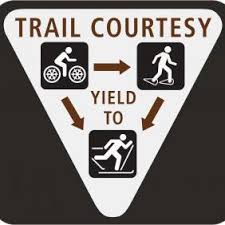Fat Biking Best Practices
We’ve put together some information on responsible ways to enjoy Fat Biking. Content on this page was developed in part by Grand Targhee Resort and Teton Valley Trails and Pathways. Thanks!

Always be courteous to other snow travelers.
What are some basic equipment guidelines for a fat bike that will be primarily ridden on snow?
- Wide tires — deep snow coverage may require tires wider than 3.5 inches.
- Tire pressure will often be less than 10 PSI.
- Enough floatation that you can travel over snow without leaving a rut deeper than one inch.
- Sufficient traction that you are able to safely control your bike and ride in a straight line.
Best Practices for Fat Biking on Groomed Nordic Trails
- Fat Biking is not allowed on any trails groomed for Nordic Skiing at Larch Hills. The items below apply to those areas that allow it.
- Only ride at ski areas that allow and encourage biking.
- Yield to all other users when riding. Skiers don’t have brakes but you do!
- Ride on the firmest part of the track.
- Do not ride on or in any nordic classic tracks.
- Leave room for skiers to pass (don’t ride side-by-side with all of your buddies blocking the full trail).
- Allow the track time to set up after grooming and before riding.
- Be an ambassador for the sport: stay polite, educate other riders, discourage bad behavior and follow the rules.
- Help out and get involved by joining your local nordic club.
- Consider donating money for trail grooming.

Best Practices for Riding on Snowmobile Trails
- When riding on snowmobile trails, use a front white blinker and rear red blinker at all times. Wear reflective material on both the front and rear of your body.
- Stay to the far right of the trail and yield to snowmobiles.
- Know and obey the rules of your local land manager. Understand that some trails may be on private property and might not be open to alternative uses.
- Be prepared. Winter travel in the backcountry requires carrying proper gear and dressing properly. Be self-sufficient!
- Use extreme caution when riding at night. Be visible and use the brightest lights you can find.
- Be friendly! Fat bikers are the newest trail users. Be courteous and open to suggestions from snowmobile riders.
- Help out by supporting your local snowmobile club.
- Consider donating to trail grooming and maintenance efforts.
Best Practices for Riding on Natural Terrain and in the Backcountry
In the right conditions, a fat bike can be the ultimate winter backcountry travel tool. Frozen conditions and minimal snow coverage (1-5 inches) means access to areas that are impassible during the warmer months. But just because you can ride somewhere doesn’t mean you should. Be aware and be prepared.
- Do not trespass! Know whether or not you are on private property. Obey ALL land manager rules. Some land parcels are closed to bikes whether you are riding on a trail or not.
- Do not ride through sensitive wildlife habitats. This may be especially important on beaches or in places where animals hibernate. Learn about the area you want to ride in before you ride there.
- Do not disturb wildlife. Many species survive on minimal diets during winter. Stressors or the need to move quickly can deplete their energy stores.
- Learn safe ice travel. Riding on frozen water can be extremely dangerous. Is the ice thick enough to support you? Take ice fishing picks and a length of rope when riding on lakes and rivers.
- Understand changing conditions. New snowfall or warming temperatures can make the return trip much more difficult. Tire tracks can be covered, hard snow can turn to slush, rivers can start to melt. Always know the forecast and be aware of how changing conditions might alter the safe passage of your route.
- Be prepared. Carry provisions in case you have to stay out longer than planned.
- Let people know. Make sure someone else knows where you are going, when you left and when you expect to return.
- Learn to share. Be aware that your tracks might attract other riders. Understand that “your” route might not remain a secret for long.
